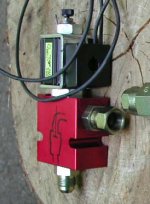Well, I did a lot of reading and looking around and talking to a friend who own a hydraulic shop. I found out that for locking the outriggers booms on big equipment they always has a Hydraulic Lock Valve installed on them.
Some have the valve right on the piston so if a hose breaks somewhere in the system the guy two stories up in the air doesn't come crashing down.
It's a two way locking valve that once the control lever is in the neutral position the piston locks whether it is up down wherever it stops, the piston it stays there. If you lifted up the tractor to remove a tire there is no chance or much less of chance the outrigger will leak down while you're getting the tire fixed.
Are you ever digging and every now and then have to lower the outrigger more because it slowly leaks down this will stop that also.
When the lever is in neutral its locked. When its parked tractor off, and you hit the lever its still locked and kids can't lower the outriggers.
When parked outriggers are up that is where they will stay, Unless your cylinder is leaking by the seal. In that case you replace the seal.
This is what one has to do to Automatically lock a piston anytime the control valve is in neutral.
The plus side you don't have to worry about unlocking or locking outriggers.
You would have to mount the valve under the deck of the backhoe, where there is plenty of room, but you would also have to remake the hoses.
One valve for each side two lines to the valve, two lines to the piston.
Someday this it what I am going to do.
But for now, I'm just going to play with my Ball Valves for a while. For a WaxMan Only Mod
These valves come in a couple of different styles and price range.
This one 1/4 npt fitting most are 1/2.
Northern Tool has one like this but 1/2 npt. The Northern has an adjustment valve so that might be a better choice, just have to use reducer bushing to 1/4
Lock Valves - Port Size: 1/4'' NPT, Type: Double
SKU: #280360
Product Specifications
Designed to lock a cylinder or part of a circuit while a directional control valve is in the neutral position. With directional control valve in neutral position, flow from both ends of cylinder is blocked locking cylinder piston in position. When directional control valve is shifted to direct flow to one side of the cylinder, pressure opens the check ball and simultaneously moves the piston over to the opposite side of the valve opening this check valve allowing free flow return to the directional control valve. Max:15 GPM, 3000 PSI.
Spool Type Port Size
Double 1/4" NPT
Here are some more
Metro Machine Lock Valve-4 Port, Model# 408-04 | Machine Selector Valves| Northern Tool + Equipment
LOCK VALVE 1/2" NPT 25 GPM 3000 PSI
I also checked the pressure it takes to hold up the outrigger, 60 psi
So while the tractor is sitting parked there is always 60 psi of pressure pushing that oil somewhere by the weight of the outrigger. As it drops down the leverage is increased and the pressure goes up and it would drop faster the lower it gets. If I push on it the pressure goes over 100psi Just left alone 60






